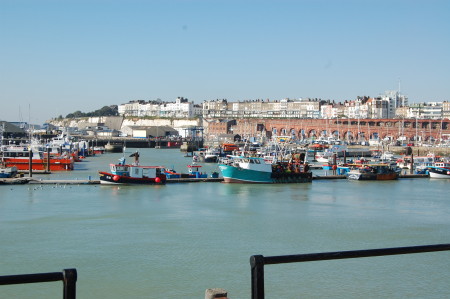Thirty one members of the Rye Conservation Society set off on a glorious day, September 30, to visit Ramsgate, to be shown round part of the harbour by members of the Ramsgate Society. They then visited The Grange, home of Augustus Pugin (1812- 1852) and also his St Augustine’s Church next door. Pugin’s most famous work is, of course, the interior of the Palace of Westminster.
En route, Jane Fraser Hay pointed out the village of Minster and told us its interesting history, so that at a future date we may care to visit it for ourselves. On arrival at Ramsgate we walked along the sea wall, which gave splendid views of the town and the Regency and later 19th century terraces that show the town’s fashionable past.
We were then guided along the divide between the inner and outer harbour (shown below) and shown how boats docked and also how in the past, the silt and mud that accumulated were flushed away. This also related to how Rye needs to keep ensuring the silt does not accumulate.
We viewed the Sailors’ Church before walking back to the centre of the town for a delicious lunch, in a very interesting restaurant with a rather pavilion like interior.
After lunch we set off for The Grange, the house Pugin built for his family. It was completed in 1844, when Pugin was at the height of his fame as the leader of the gothic revival and he had decided to live in Ramsgate for various reasons.
He had happy memories of holidays in the town, where a favourite aunt had lived; he liked the sea and sailing and there were good communications to both London and the continent, and lastly, as a Catholic convert, he wanted to be near the site where St Augustine landed in 597 AD.
When building his house he envisaged not only the house, but also a Catholic parish church together with a Benedictine monastery. Inside we had an excellent guide, who introduced us to Pugin’s idea that you designed houses from the inside to the out.
The rooms were domestic and had been restored with Pugin’s wallpaper, with his motto, en avant, as part of the decoration. The colours were rich reds, blues and greens, befitting a person wanting to return to the Middle Ages.
After he died his son followed as an architect in the same style and built the famous Granville Hotel in the town as well as other buildings. His son Cuthbert was the last of the family to live at the house and he died in 1928.
Next we visited the church which was built over time at his own expense. Pugin used flints for the outside and sandstone for the interior. He very much wanted to return to the high standard of stained glass as seen in the medieval period and in this he was helped by his collaboration with John Hardman of Birmingham.
This firm stayed in that family, with John Hardman Powell becoming Pugin’s son-in-law and today it still trades as Pugin, Hardman & Powell. There is some restoration work to be done in the church, in that the rood screen is to be put back and the choir stalls arranged to Pugin’s original design.
Tea followed with the cakes reflecting Pugin’s rich and sumptuous approach to stained glass. Shall we see a rival of Pugin design in Rye after this visit? We shall wait and see. All our thanks went to John and Helen Griffiths for organising such an excellent day out.

Photos: Kenneth Bird



